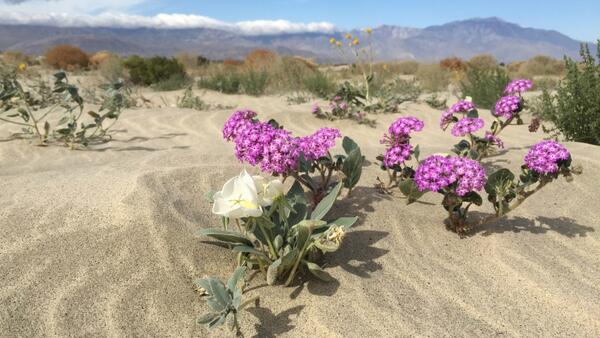When do wildflowers bloom?
“Study nature, love nature, stay close to nature. It will never fail you.” — Frank Lloyd Wright
One of the many mysteries of mysteries of nature, one of those riddles wrapped within an enigma for desert naturalists to ponder, is “what factors determine when annual wildflowers will bloom?”
Clearly the amount and timing of desert rainfall are critical variables. However, what appears to be nearly identical rainfall amounts during nearly identical seasons can yield very different bouquets of wildflowers. So far, the reasons for these differences have eluded even the most astute naturalists. The atypical two early fall rainstorms, one in September and one in October, that wetted parts of the Colorado and Mojave Deserts this year are a case in point. The wildflowers have been patchy, but within those patches the diversity of species in bloom has been amazing, rivaling even a good spring bloom. So why? Spoiler alert – I don’t have the answer, but I’d like to present my hypothesis.
Annual desert wildflowers spend the bulk of their existence as seeds buried in desert soils. Those seeds are referred to as the “seed bank” and they can wait there for decades, thirty or more years. For some it may be closer to a century before they finally lose the ability to germinate. For the hundreds of thousands (or more) years since each type of desert wildflower has been a species, each species’ seeds have been playing a species-specific evolutionary game of probabilities called natural selection, balancing the odds of being eaten by a pocket mouse, kangaroo rat or a harvester ant each year, against the odds of how much more rain might fall from the sky, together yielding them the best chances to grow, flower, and produce seeds to replenish the seed bank. Opting to germinate with the first rainfall might give those plants an advantage of lessening the chance of being eaten, and then occupying a space (receiving sunlight unshaded by competitors) and having unfettered access to often limiting organic nutrients in those desert soils.
There can be an advantage to germinating early, but there is also a risk. If no rain follows the initial storm, or if it is too cold to grow or too cold for pollinators to be out and about, the germinated seedling could easily perish without flowering or producing seeds. Not producing viable seeds means germinated plants end up as evolutionary dead ends. There is strong natural selection pressure to develop strategies to germinate at times and conditions that will maximize survival and successful seed production.
There is another variable: the length of time a given seed has been biding its time in the seed bank. The odds of waiting for just the right conditions should change depending how old those seeds are. A seed recently entering the seed bank has a high potential of maintaining its viability for at least decades. Those “young seeds” should wait for those “just right” conditions and so forego germination unless those near perfect conditions do occur. Those ideal conditions might include a series of storms, saturating the desert soils with water, “informing” the seeds that is one of those rare “wet" years in the desert and so additional storms are then more likely. Perhaps an El Niño year. Those wet years are more likely to guarantee abundant pollinators, although abundant pollinators could also mean abundant caterpillars that might mow down the young plants before they have a chance to set seeds.
Having to deal with a “caterpillar plague” increases if there are two or more wet years in close succession. The moth and butterfly populations build up during the first wet year, and then can be more abundant in subsequent years. That possibility might shift the odds in favor of germinating early in a year following multiple drought years rather than in a later in a series of wet years – finishing its life cycle and replenishing the seed bank before the caterpillar emerge or build up their populations. Or it could shift the odds in favor of germinating after a rare late summer-early fall series of rainfalls, during a time when the caterpillars are less likely to be as abundant. Conversely, older seeds, seeds that have forgone germinating during years of less-than-optimal rainfall could be getting closer to the end of their viable lifespans. So as seeds age, their calculus as to when to germinate can shift to increasingly less optimal rainfall scenarios because waiting much longer could mean not being able to germinate at all. That could mean that the desert wildflowers that emerge during less than optimum conditions are comprised of mostly older seeds, or maybe they are just risk takers, betting against the odds. Just like playing games of chance in casinos, betting on long odds rarely pays off, but when it does the payout is very good.
So, when desert wildflowers germinate and bloom is in response to not one, but many factors, each of which play a role in influencing the probability of germination yielding abundant seeds for future generations. Over my years as a desert naturalist, the most spectacular “super blooms” have occurred following multiple drought years. The winter and early spring of 2005 and 2017 were such years. Then there was 1992, overall, a very dry winter but in late February nearly two inches fell and that March the bloom was spectacular – a year we called “the miracle March." Now we might add the “fabulous fall of 2022."
Nullius in verba
Go outside, tip your hat to a chuckwalla (and a cactus), think like a mountain, and be safe
